In the Moment:
Michael Frye's Landscape Photography Blog
by Michael Frye | May 10, 2015 | Night Photography
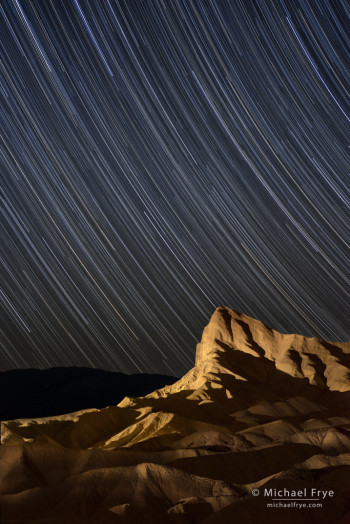
Manly Beacon at night with star trails, Death Valley NP, CA, USA
Manly Beacon is Death Valley’s most iconic feature, seen in millions of photographs from Zabriskie Point, including the image on the cover of the park map and brochure. So naturally I thought it would be fun to light it up at night.
One evening during our recent trip to Death Valley, Claudia and I, accompanied by our friend Robert Eckhardt, started down the Golden Canyon Trail from Zabriskie Point, carrying my powerful (3200 lumens), battery-powered spotlight, and radios for communication. Robert and I wanted a lower vantage point where the Beacon would poke up into the sky, and found a perfect spot. We set up our cameras and made some dusk exposures. Then after dark I hiked about half a mile further down the trail, carrying the spotlight and a radio, to a location I thought would work for the light-painting. Claudia acted as radio operator, and Robert tripped the shutters on both our cameras, while I used the spotlight to illuminate the Beacon.
We took a guess at the exposure, initially leaving the shutters open for 30 seconds at f/4, with the ISO set to 2500. According to Claudia and Robert’s radio reports, this exposure – surprisingly – turned out to be perfect. It did take several tries to get the lighting balance just right, but the problem was that the ridges underneath the Beacon weren’t getting lit from this spot. So I climbed back up the trail to a different location, closer to the cameras, which proved to be perfect for lighting those foreground ridges.
(more…)
by Michael Frye | May 3, 2015 | Night Photography
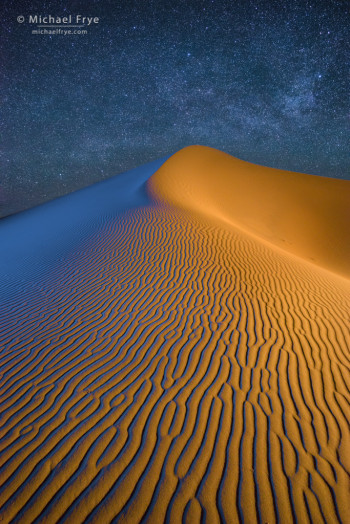
Sand dune and the Milky Way at night, Death Valley National Park
One night during our Death Valley workshop we went out to the sand dunes. After some searching, I found this wonderful dune with it’s rippled foreground textures. Lighting it was a group project; we all set up our cameras, and took turns lighting the dune from the left and the right, trying to find the right angles to highlight those ripples. Then we set our interval timers to record star trails – and took naps on the sand while we waited for the star-trail sequences to finish. After that the Milky Way was in the right position over the dune, so before moving our cameras we made some more exposures of pinpoint stars as well.
Recording all these exposures of the same composition gave us the option of including either star trails or pinpoint stars in the final image, and having the dune lit either from the left, the right, or both. I liked the pinpoint stars better, and chose to include lighting from both sides. The final image you see here is a composite of three exposures (assembled in Photoshop using the Lighten blending mode): one for the sky, one with the dune lit from the left (colored blue), and one with the dune lit from the right.
(more…)
by Michael Frye | Mar 31, 2015 | Night Photography
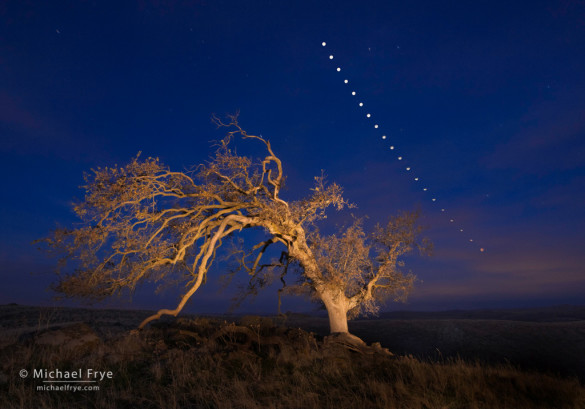
Oak tree and lunar eclipse sequence, Mariposa County, Sierra foothills, December 2011
Another total lunar eclipse will be visible in western North America this Saturday morning, April 4th. This is the third lunar eclipse in a sequence of four: we had two last year, and there will be another one on September 27th this year. But after that you won’t be able to see another total lunar eclipse in North America until 2018.
This upcoming eclipse will be brief; the total eclipse will last only five minutes! But for photography that’s enough. Here in California the eclipse will be visible in the west-southwest, about 18 degrees above the horizon, just before dawn. Since the moon will be low in the sky, you might be able to photograph it next to an interesting foreground object. You can find more details about this eclipse here.
For precise guidance about the moon’s position in relation to the landscape, I recommend consulting PhotoPills or The Photographer’s Ephemeris. Here’s the timing for the eclipse:
(more…)
by Michael Frye | Feb 12, 2015 | Night Photography
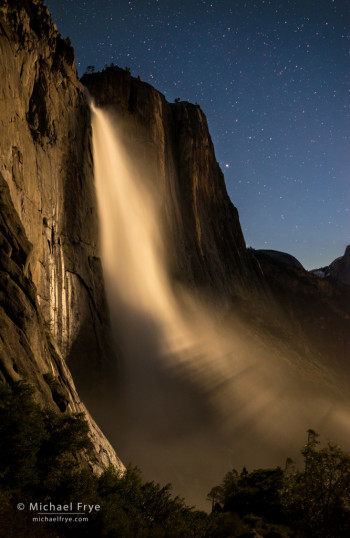
Upper Yosemite Fall illuminated by the rising moon, Monday night
After photographing Horsetail Fall on Monday evening I was thinking about heading home, but it occurred to me that this might be the perfect night to make a photograph I had been thinking of, with Upper Yosemite Fall backlit by the rising moon. The moon was due to rise about 11:00 p.m. Consulting PhotoPills, it seemed like the angle and phase of the moon were about right. And with the waterfalls so full, plus cloud-free skies, it seemed unlikely that I’d ever find better conditions.
So I decided to go for it. I had dinner at the Food Court at Yosemite Lodge, then connected to the Lodge wi-fi and answered emails for awhile. About 8:30 I headed up the trail.
Hiking the Upper Yosemite Falls Trail in the dark was a strange, surreal experience. I’d been up this trail at night before, but under a full moon. Prior to the moonrise Monday night it was very dark, with the only light coming from the stars. I had to use my headlamp to negotiate the rocky trail, and the bright light ruined my night vision. When I came around the bend where you typically get your first view of the upper fall, I could hear it, and feel the spray, but couldn’t see it at all. I had to turn off my headlamp and let my eyes adjust for a minute, and then I could just make out a tall, skinny triangle of less-than-pure-blackness ahead of me – the waterfall.
I didn’t get as wet as expected going past the base of the fall; I’ve been soaked at this spot before, but the water level apparently wasn’t as high this time. But the waterfall was loud. I arrived at my spot early, and had time to try out different compositions before the moon rose.
(more…)
by Michael Frye | Dec 30, 2014 | Announcements
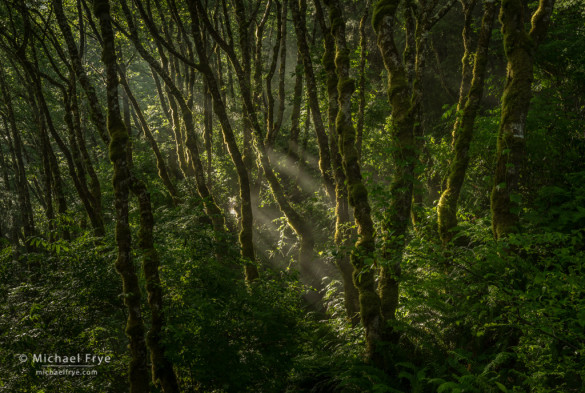
Alders and sunbeams, Redwood NP. My most popular post in 2014 was a review of the Sony A7r, the camera used for this photo. The Sony sensor allowed me to capture great detail, and also lighten shadows without generating noise.
With the new year approaching, it seems like a good time to look back at my most popular posts from 2014:
Should Your Next Camera be a Sony?
I don’t talk about equipment very often, because more gear won’t make you a better photographer. But I felt compelled to test – and write about – the Sony A7r because Canon has been so slow to make improvements to their full-frame sensors, and the A7r offers a higher-resolution, low-noise body that can be used with Canon lenses. Plus it’s a mirrorless camera, and I wanted to see if an electronic viewfinder could work for serious landscape photography.
(more…)













